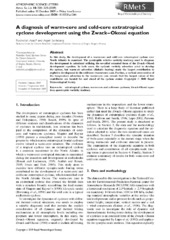| dc.contributor.author | Azad, Roohollah | eng |
| dc.contributor.author | Sorteberg, Asgeir | eng |
| dc.date.accessioned | 2013-05-15T12:03:58Z | |
| dc.date.available | 2013-05-15T12:03:58Z | |
| dc.date.issued | 2009 | eng |
| dc.Published | Atmospheric Science Letters 10(4): 220-225 | eng |
| dc.identifier.issn | 1530-261X | en_US |
| dc.identifier.uri | https://hdl.handle.net/1956/6612 | |
| dc.description.abstract | In this study, the development of a warm-core and cold-core extratropical cyclone over North Atlantic is examined. The geostrophic relative vorticity tendency used to diagnose the development is calculated utilizing the so-called extended form of the Zwack–Okossi development equation. In both cases, the cyclonic vorticity advection acted to develop the system, but warm-air advection (diabatic heating) made the largest contribution to explosive development in the cold-core (warm-core) case. Further, a vertical cross section of the temperature advection in the warm-core case reveals that the largest values of this contributor are located far and ahead of the cyclone center. | en_US |
| dc.language.iso | eng | eng |
| dc.publisher | Royal Meteorological Society and Wiley-Blackwell | en_US |
| dc.subject | Extratropical cyclone | eng |
| dc.subject | Warm-core and cold-core cyclones | eng |
| dc.subject | Zwack-Okossi equation | eng |
| dc.subject | Geostrophic vorticity tendency | eng |
| dc.title | A diagnosis of warm-core and cold-core extratropical cyclone development using the Zwack–Okossi equation | en_US |
| dc.type | Peer reviewed | |
| dc.type | Journal article | |
| dc.description.version | publishedVersion | en_US |
| dc.rights.holder | Copyright 2009 Royal Meteorological Society | en_US |
| dc.identifier.doi | https://doi.org/10.1002/asl.244 | |
| dc.identifier.cristin | 509085 | |
| dc.source.journal | Atmospheric Science Letters | |
| dc.source.40 | 10 | |
| dc.source.14 | 4 | |
| dc.source.pagenumber | 220-225 | |
